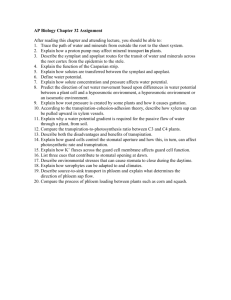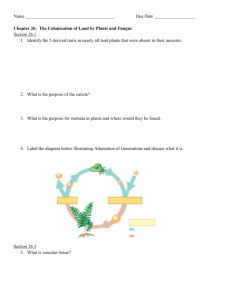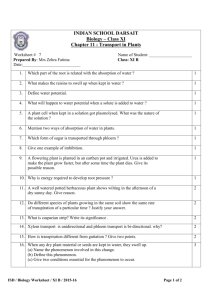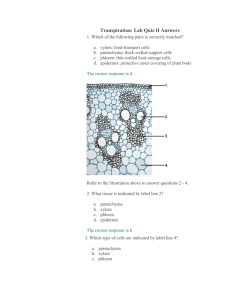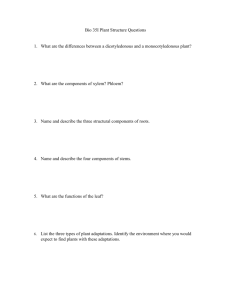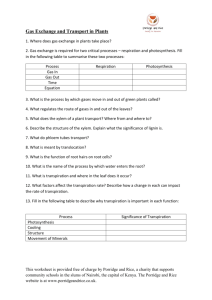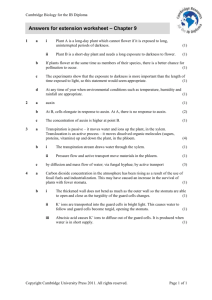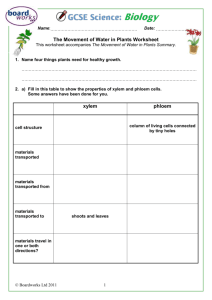Topic 9: AHL Plant Biology
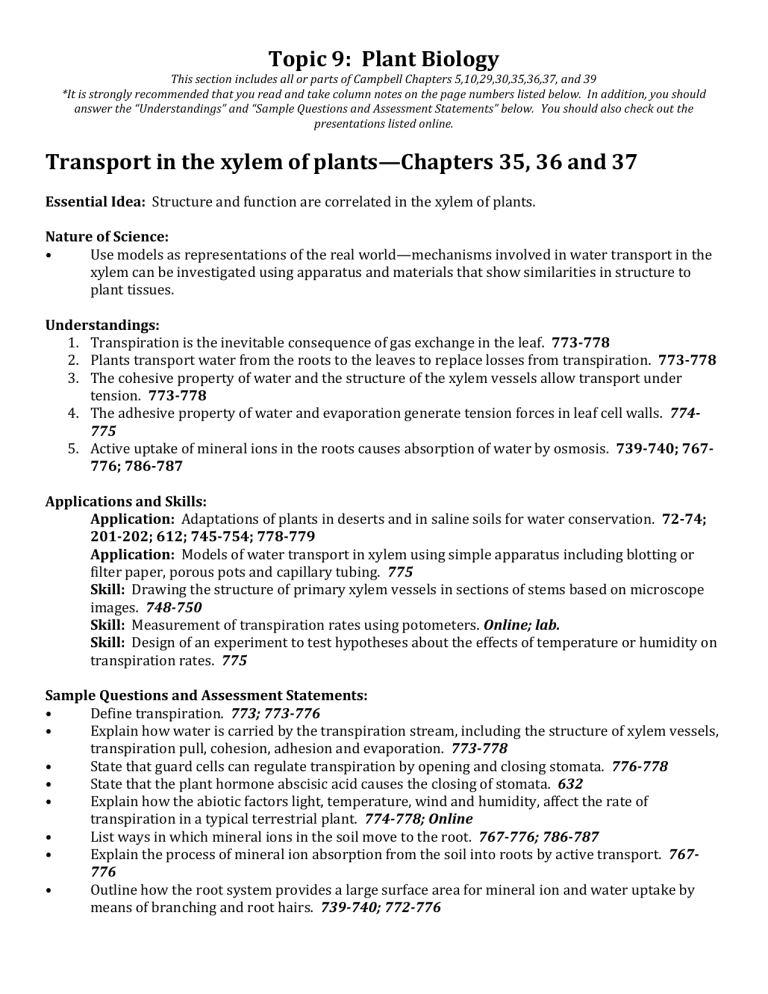
Topic 9: Plant Biology
This section includes all or parts of Campbell Chapters 5,10,29,30,35,36,37, and 39
*It is strongly recommended that you read and take column notes on the page numbers listed below. In addition, you should answer the “Understandings” and “Sample Questions and Assessment Statements” below. You should also check out the presentations listed online.
Transport in the xylem of plants—Chapters 35, 36 and 37
Essential Idea: Structure and function are correlated in the xylem of plants.
Nature of Science:
• Use models as representations of the real world—mechanisms involved in water transport in the xylem can be investigated using apparatus and materials that show similarities in structure to plant tissues.
Understandings:
1.
Transpiration is the inevitable consequence of gas exchange in the leaf. 773-778
2.
Plants transport water from the roots to the leaves to replace losses from transpiration. 773-778
3.
The cohesive property of water and the structure of the xylem vessels allow transport under tension. 773-778
4.
The adhesive property of water and evaporation generate tension forces in leaf cell walls. 774-
775
5.
Active uptake of mineral ions in the roots causes absorption of water by osmosis. 739-740; 767-
776; 786-787
Applications and Skills:
Application: Adaptations of plants in deserts and in saline soils for water conservation. 72-74;
201-202; 612; 745-754; 778-779
Application: Models of water transport in xylem using simple apparatus including blotting or filter paper, porous pots and capillary tubing. 775
Skill: Drawing the structure of primary xylem vessels in sections of stems based on microscope images. 748-750
Skill: Measurement of transpiration rates using potometers. Online; lab.
•
•
•
•
•
•
•
Skill: Design of an experiment to test hypotheses about the effects of temperature or humidity on transpiration rates. 775
Sample Questions and Assessment Statements:
Define transpiration. 773; 773-776
Explain how water is carried by the transpiration stream, including the structure of xylem vessels, transpiration pull, cohesion, adhesion and evaporation. 773-778
State that guard cells can regulate transpiration by opening and closing stomata. 776-778
State that the plant hormone abscisic acid causes the closing of stomata. 632
Explain how the abiotic factors light, temperature, wind and humidity, affect the rate of
• transpiration in a typical terrestrial plant. 774-778; Online
List ways in which mineral ions in the soil move to the root. 767-776; 786-787
Explain the process of mineral ion absorption from the soil into roots by active transport. 767-
776
Outline how the root system provides a large surface area for mineral ion and water uptake by means of branching and root hairs. 739-740; 772-776
•
•
State that terrestrial plants support themselves by means of thickened cellulose (72-74), cell turgor (769-770) and lignified xylem (745). 612; 747-754
Outline four adaptations of xerophytes that help to reduce transpiration. 201-202; 778-779
Utilization: Syllabus and cross-curricular links:
Biology
Topic 2.2 Water
Topics 2.9 and 8.3 Photosynthesis
Aims:
•
•
Aim 7: The introduction of image processing software and digital microscopes increases further the ability to gather more data to ensure reliability.
Aim 6: Measurement of stomatal apertures and the distribution of stomata using leaf casts, including replicate measurements to enhance reliability, are possible experiments.
Transport of Phloem of Plants—Chapter 36
Essential Idea: Structure and function are correlated in the phloem of plants.
Nature of Science:
• Developments in scientific research follow improvements in apparatus—experimental methods for measuring phloem transport rates using aphid stylets and radioactively-labeled carbon dioxide were only possible when radioisotopes became available.
Understandings:
1.
Plants transport organic compounds from sources to sinks. 778-780
2.
Incompressibility of water allows transport along hydrostatic pressure gradients. 773-778
3.
Active transport is used to load organic compounds into phloem sieve tubes at the source. 779-
780
4.
High concentrations of solutes in the phloem at the source lead to water uptake by osmosis. 779-
780
5.
Raised hydrostatic pressure causes the contents of the phloem to flow towards sinks. 779-780
Applications and Skills:
Application: Structure-function relationships of phloem sieve tubes. 745; 779-780
Skill: Identification of xylem and phloem in microscope images of stem and root. 748-750
Skill: Analysis of data from experiments measuring phloem transport rates using aphid stylets
• and radioactively-labeled carbon dioxide. Online
Sample Questions and Assessment Statements:
Outline the role of phloem in active translocation of sugars (sucrose) and amino acids from source
(photosynthetic tissue and storage organs) to sink (fruits, seeds, roots). 779-780
Growth in Plants—Chapters 30, 35, and 39
Essential Idea: Plants adapt their growth to environmental conditions.
Nature of Science:
• Developments in scientific research follow improvements in analysis and deduction— improvements in analytical techniques allowing the detection of trace amounts of substances has led to advanced in the understanding of plant hormones and their effect on gene expression.
Understandings:
1.
Undifferentiated cells in the meristems of plants allow indeterminate growth. 625; 626; 630; 631;
746-754; 748; 750
2.
Mitosis and cell division in the shoot apex provide cells needed for extension of the stem and development of leaves. 747-750
3.
Plant hormones control growth in the shoot apex. 824-830
4.
Plant shoots respond to the environment by tropisms. 821-845
5.
Auxin efflux pumps can set up concentration gradients of auxin in plant tissue. 827-831
6.
Auxin influences cell growth rates by changing the pattern of gene expression. 824-830
Applications and Skills:
Application: Micropropagation of plants using tissue from the shoot apex, nutrient agar gels and growth hormones. Online.
Application: Use of micropropagation for rapid building up of new varieties, production of virusfree strains of existing varieties and propagation of orchids and other rare species. Online.
Sample Questions and Assessment Statements:
• State that dicotyledonous plants have apical and lateral meristems. 625; 626; 630; 631; 746-747;
748; 750
•
•
Compare growth due to apical and lateral meristems in dicotyledonous plants. 747-754
Explain the role of auxin in phototropism as an example of the control of plant growth. 824-830
Guidance: Auxin is the only named hormone that is expected.
TOK:
• Plants communicate chemically both internally and externally. To what extent can plants be said to have language?
Utilization:
Micropropagation is used for rapid bulking up of new varieties of plant. •
Aims:
• Aim 6: Investigations into tropisms could be carried out.
Reproduction in Plants—Chapter 39
Essential Idea: Reproduction in flowering plants is influenced by the biotic and abiotic environment.
Nature of Science:
• Paradigm shift—more than 85% of the world’s 250,000 species of flowering plant depend on pollinators for reproduction. This knowledge has led to protecting entire ecosystems rather than individual species.
Understandings:
1.
Flowering involves a change in gene expression in the shoot apex. 835-841
2.
The switch to flowering is a response to the length of light and dark periods in many plants. 835-
841
3.
Success in plant reproduction depends on pollination (620; 804-805), fertilization (802-804;
806-809) and seed dispersal (811).
4.
Most flowering plants use mutualistic relationships with pollinators in sexual reproduction. 632;
804-805
Applications and Skills:
Application: Methods used to induce short-day plants to flower out of season. 835-841; Online
Skill: Drawing internal structure of seeds. 807-811
Skill: Drawing of half-views of animal pollinated flowers. 625; 761; 802
Skill: Design of experiments to test hypotheses about factors affecting germination. 808-809;
831
Sample Questions and Assessment Statements:
•
•
•
Distinguish between pollination (620; 804-805), fertilization (802-804;806-809) and seed dispersal (811).
Draw and label a diagram showing the external and internal structure of a named dicotyledonous seed. 807-811
Draw and label a diagram showing the structure of a dicotyledonous animal-pollinated flower.
625; 802; Online
•
•
•
•
•
Explain how flowering is controlled in long-day and short-day plants, including the role of phytochrome. 835-841
Explain the conditions needed for the germination of a typical seed. 808-809; 831
Outline the metabolic processes during germination of a starchy seed. 831
Guidance:
Students should understand the differences between pollination, fertilization and seed dispersal, but are not required to know the details of each process.
Flowering in so-called short-day plants such as chrysanthemums, is stimulated by long nights rather than short days.
Utilization:
• The University of Göttingen, in Germany, conducted an extensive review of scientific studies from
200 countries for 115 of the leading global crops in 2005. They found that 87 of the crop plants depend to some degree upon animal pollination, including bees. This accounts for one-third of crop production globally.
